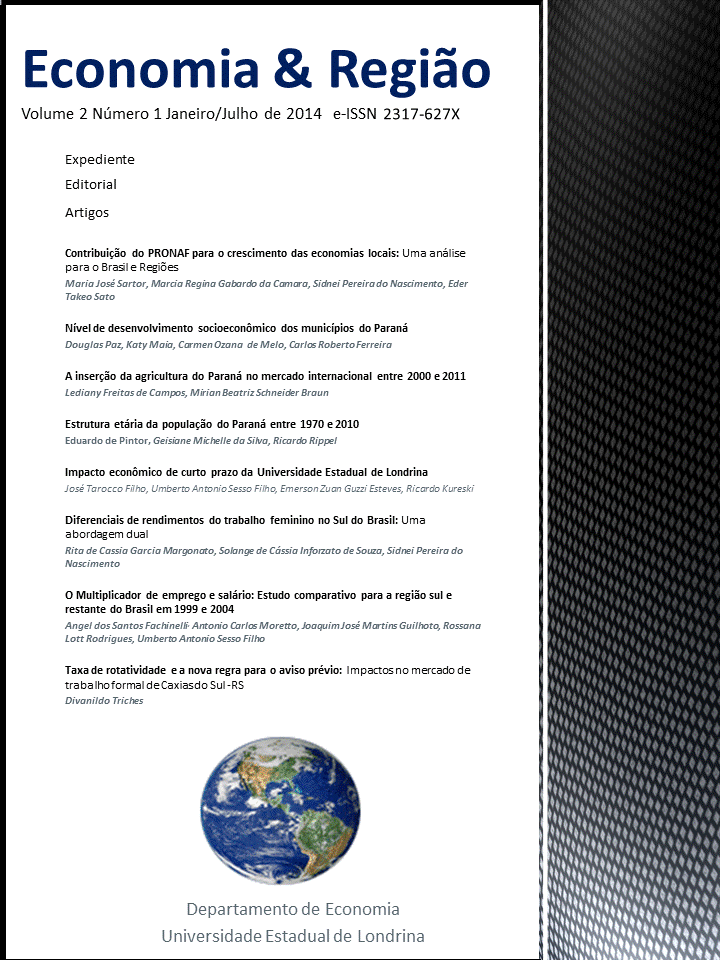The Turnover and the new rules for communication dismissal: Impacts in the formal labor market of Caxias do Sul -RS
DOI:
https://doi.org/10.5433/2317-627X.2014v2n1p146Keywords:
Job market, Metal and mechanic sector, Turn over, communication for dismissalAbstract
This paper aims to evaluate the additional cost and impacts of the new rule for communication dismissals evaluate inside the job market of metal and mechanic industries of Caxias do Sul. The results pointed out that the formal job market of the Brazilian metallurgic and mechanic sectors increased substantially more than 6% per year from 2005 to 2011. The Caxias do Sul's job market participate 2,4% of the amount of Brazil and 23,0% of state for Rio Grande do Sul. The transport material segment leads the demand for job among other metal and mechanic sector. The high turnover, about 35%, was register in Rio Grande do Sul and Caxias do Sul, while for the country was 28% from 2005 to 2011 The feeder production line was the job with the greatest dismissals after coming the welder job. The majority of dismissals which took place in metal and mechanic industries were classified " without right reason" and almost a third of dismissals were by employer's own initiative. The weighted additional cost by duration of job of new rule communication dismissals was variable. It was estimated on the range from 31.4% to 59.4%, considering only the proportion of worker with additional costs.Downloads
References
CLASSIFICAÇÃO NACIONAL DE ATIVIDADES ECONÔMICAS - CNAE. IBGE. Disponível em: http://www.cnae.ibge.gov.br/estrutura.asp?TabelaBusca=CNAE_200@CNAE 2.1 .
COSTA, Jaqueline S.; CASTRO, Magnus W. ROCHA, Josiene, F.Uma análise de previsão, utilizando Box-Jenkins para a taxa de rotatividade da mão-de-obra aplicada ao Espírito Santo, Instituto Jones dos Santos, SEP/ES, Vitória, 2010, 33 p. (Nota Técnica nº 12).
GONZAGA, Gustavo. Rotatividade e qualidade do emprego no Brasil. Revista de Economia Política, v.18, n. 1, p. 120 -140, jan./mar. 1998.
PASTORE, José. As causas da Rotatividade Revista de Relações do Trabalho CNI 12/08/2001.
ORELLANO, V. I. F; PAZELLO, E. T. Evolução e determinantes da rotatividade da mão-de-obra nas firmas da indústria paulista na década de 1990. Pesquisa e Planejamento Econômico, v.36, n.1, p.134 -165, 2006.
RAMOS, Carlos A.; CARNEIRO, Francisco G. Os determinantes da rotatividade do trabalho no Brasil: instituições x ciclos econômicos. Nova economia, UFMG, v.10 n.3, p. 78-97, 2002.
SINDICATO DAS INDÚSTRIAS METALÚRGICAS, MECÂNICAS E DE MATERIAL ELÉTRICO DE CAXIAS DO SUL -SIMECS. Sistema de Indicadores do SIMECS. Disponível em http://indicadores.simecs.com.br/rh/.
Downloads
Published
How to Cite
Issue
Section
License
Copyright (c) 2014 Economia & Região

This work is licensed under a Creative Commons Attribution 4.0 International License.
Economia & Região adota a Licença Creative Commons Attribution CC-BY 4.0 International, portanto, os direitos autorais relativos aos artigos publicados são do(s) autor(es), que cedem à Revista Economia & Região o direito de exclusividade de primeira publicação.
Sob essa licença é possível: Compartilhar - copiar e redistribuir o material em qualquer suporte ou formato. Adaptar - remixar, transformar, e criar a partir do material, atribuindo o devido crédito e prover um link para a licença e indicar se mudanças foram feitas.




















